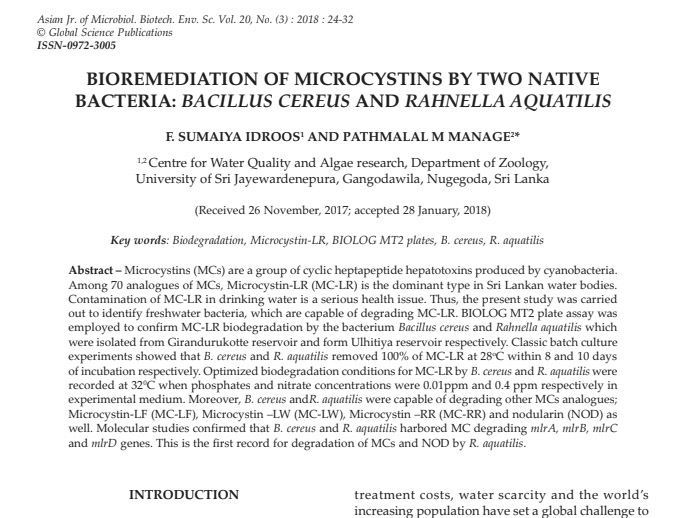Authors: Tharindu Madhusanka and Pathmalal Manage
Journal: Asian Journal of Microbiology, Biotechnology & Environmental Sciences.
There is a growing concern on the use of alternative sustainable energy source to overcome the energy crisis. Hence, biodiesel from cyanobacteria has drawn the attention of the scientific community. The present study was carried out to find potential utilization of Microcystis bloom for biodiesel production. Microcystis bloom samples were collected from Beira Lake, Sri Lanka and Soxhlet extraction method with Isopropanol: n-hexane (3:2) solvent system was employed to extract lipids. In the present study,biodiesel B6 blend was prepared and the properties of B6 blend were compared with ASTM D 7467(American Society for Testing and Materials standard for B6 – B20 Biodiesel blends)and Ceylon Petroleum Corporation specifications for no: 02-grade auto diesel to confirm the fuel properties and the usability respectively. Biodiesel B6 blend was subjected to determination of fuel properties and density at 15oC (ASTM D 1298/ 4052), Viscosity Kinematic at 60oC (ASTM D 445), Calorific value (Gross) (ASTM D240), Cloud point (ASTMD 2500), Lubricity (HFRR wear sear dia at 60oC) (ASTM D 6079), Sulphur content (ASTM D 4294) and CFPP (Cold Filter Plugging Point) value (ASTM D 6371) were 831.00kg/m3, 2.83cSt., 11180.00kcal/kg, 6oc,405.00μm, 2310.00ppm and 4oC. The results revealed that biodiesel B6 blend complied with ASTM standards for lubricity, kinematic viscosity and sulfur content (S5000). The fuel properties of kinematic viscosity, density, sulfur content and CFPP value complied with the Ceypetco auto diesel specifications and the energy content of the blend was higher than Ceypetco auto diesel specifications. The results of the present study revealed that the Microcystis bloom can be utilized as a potential candidate to produce biodiesel.



